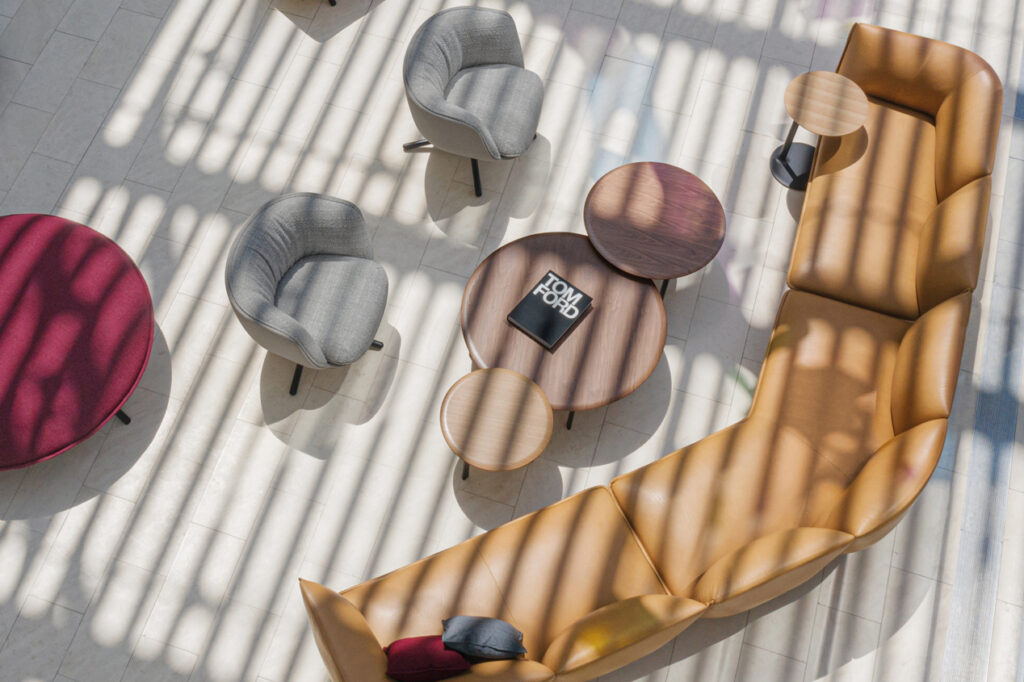Office Furniture Maintenance

Office furniture maintenance is essential to protecting your investment, especially if you have leather or wood furniture that may require additional care. Knowing how to maintain office furniture properly means understanding how different materials should be cared for. Maintenance for wooden furniture is often different from leather furniture maintenance, for instance.
Below are some tips on office furniture maintenance, from preventive maintenance and eliminating odors to avoiding environmental damage and maintaining desks and chairs.
Preventive Maintenance
The first step in maintaining your office furniture is to take proactive measures:
- Coasters: Use coasters on every desk and side table you can. Different materials react differently to heat and moisture, so coasters can help prevent damage. Use boards or dish towels when putting hot foods on breakroom tables and office desks. If you have wood furniture, this is particularly important, as heat and moisture can cause discoloration.
- Felt pads: Place felt pads under lamps, telephones, laptop stands or other accessories that might scratch or damage furniture. Create a barrier between paper and wooden desks. If you write hard enough, it can damage the desk.
- Rugs and mats: Use rugs and mats under chairs to prevent scratches on the floor and damage to the feet of chairs.
- Climate control: Too much heat or cold can affect office furniture. Ensure furniture is far enough from heating or cooling systems, as excess heat or cold can damage furniture.
- Furniture rules: Create a set of furniture rules. No feet on desks or chairs, no sitting on tables, no eating at your desk and other practices can prevent furniture damage.
Avoid Environmental Damage
A significant part of proactive maintenance is avoiding environmental damage. Moisture and the sun can damage all types of furniture materials. When you design your office, take note of the weather and climate of the area, including humidity.
Dehumidifiers and humidifiers can help balance the moisture level in your office. Too much moisture can cause wood furniture to warp, while a lack of moisture can dry out furniture, especially leather. Warping or drying out can lead to visible cracks and damage that can be difficult to repair.
Keep furniture away from direct sunlight, too. Leather will dry out, as UV rays eliminate moisture and oils in the material. Upholstery and wooden furniture can fade after extended exposure. The heat from vents and furnaces can also fade and damage furniture. Take the time to set up your office to protect your furniture from the elements.
Weekly Office Furniture Maintenance
A weekly maintenance schedule can extend the life of your furniture. You’ll get rid of the dirt that can build and cause problems. It’s also a great way to spot potential issues, such as drying leather or fading upholstery, so you can take steps to rectify them.
Leather
Leather requires little maintenance if used correctly. Dust leather furniture with a soft cloth weekly to maintain its look. Leather will repel most liquids unless they are left to soak for a long time, so you should address spills as soon as possible to prevent staining and damage.
Here’s how to clean leather office furniture based on the issue you see:
- Spills: Clean up the spill with a clean, absorbent cloth. Pat dry with a clean towel and let it air dry. Avoid rubbing while cleaning.
- Stubborn stains: Apply a mild solution of lukewarm water and ivory soap to a sponge or cloth, then rub it into the stain. With a clean, damp sponge, remove soap from the leather and let the furniture air dry. Perform a spot test to see if the solution will cause the color to run or fade.
- Grease spots: Use a clean, lint-free cloth to blot the area thoroughly. There is no need for water or soap, as the spot should fade into the leather shortly.
Avoid saddle soap, furniture polish, varnish or other harsh cleaners, as they can damage leather.
Vinyl
Vinyl is commonly used as a substitute for leather because it’s durable and requires minimal maintenance. Use mild soap and warm water weekly to remove regular dirt and smudges. More stubborn dirt might need a bristle brush. You can also let the water stand for a short time before wiping it away. Consider investing in a protective finish that will help protect your furniture from heavy soiling. As with leather, avoid using harsh detergents, as they can scratch the material.
Wood
Wood and wood veneers are widely used to make furniture. They both require regular cleaning and maintenance to remain in top shape. If the wood is untreated, use a dry cloth before applying treatment oil. Treated wood can withstand a damp cloth and polish every week. Excess water can create stains on wood, so avoid a wet cloth.
Upholstery
Furniture with upholstery will often come with specific care instructions from the manufacturer. An excellent place to start is to vacuum upholstery furniture every week and wipe the fabric down with a damp cloth. To get rid of stubborn stains and odors, consult the care instructions. However, a wet cloth and the appropriate fabric shampoos can be enough. Always do a spot check to see how the material will handle it.
Maintaining Office Desks and Chairs
Nearly every employee in the office uses a desk and a chair. Ensuring these pieces are properly maintained can extend their life span.
Office Desk Maintenance
One of the best ways to ensure office desks are properly maintained is keeping them clean and clutter-free. A clean and organized desk has many benefits for employees. An organized desk can positively affect employees’ productivity, mental health and how they view each other. Implement an organized or clean desk policy that encourages staff to eat away from their desks and clear off the surface at the end of the day.
An organized desk will be easier for the janitorial team to clean. Office desks need to be dusted or wiped down weekly, regardless of the material. Use a dry cloth or duster to remove dust. If there is a build-up of dirt, use a damp cloth and a mixture of water and soap to remove it. Avoid harsh chemicals or polishing sprays, which can damage the desk’s surface, leave streaks and ruin finishes. Check the manufacturers’ instructions when deciding which products to use.
Office Chair Maintenance
Chairs should be cleaned every two weeks. The material the chair is made of will determine how to clean it. Leather, wood and fabric need to be cleaned accordingly. Also, different parts of a chair may be made out of different materials, requiring specific care.
Most chairs can be wiped with a dry or damp cloth to clean dirt and dust. You can vacuum fabric and mesh chairs to remove any debris. Take care when wiping down mesh chairs — dab the cloth on the chair rather than dragging it to avoid damaging the mesh. Always follow the manufacturer’s care instructions if you need to wash fabric chairs.
Eliminating Odors
Weekly and daily cleaning can help prevent odors. If the smell is persistent, there are a few tricks you can use to get rid of the odor:
- Vinegar and water: Mix equal parts water and vinegar to create a cleaning solution. Use a soft microfiber cloth to wipe down the furniture. Make sure you use slightly damp cloths on leather to prevent water damage.
- Lemon oil: This powerful cleaner can remove various smoke smells.
- Bleach and water: For more stubborn smells on plastic and vinyl, try one part bleach mixed with 10 parts water. Wipe down the furniture in a well-ventilated area and let it air dry.
- Baking soda: Get rid of smells on wood and leather furniture with baking soda. Leave the powder on overnight or over the weekend and then gently wipe it off.
- Charcoal: Put pieces of charcoal at the back of desk drawers to absorb any odors.
- Commercial cleaner: Look for commercial cleaners specifically for furniture if the other methods cannot remove the odor.
Professional Furniture Project Management and Procurement With WB WOOD
The type of furniture you choose can significantly impact its maintenance and cleaning. By partnering with WB WOOD, you can rest assured you are choosing a reliable furniture service provider who can help bring the vision for your office to life. Our professional team will help you procure quality office furniture, from seating and storage pieces to tables and workspaces.
Contact us today for professional furniture procurement services!
Sources:
